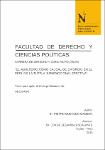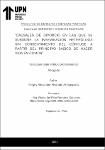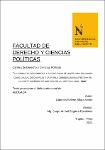Mostrar el registro sencillo del ítem
Propuesta normativa para el adulterio cibernético como causal de divorcio en el Código Civil peruano
| dc.contributor.advisor | Rosario Pacahuala, Emilio Augusto | |
| dc.contributor.author | Sotomayor Salas, Estuardo Nicolas | |
| dc.date.accessioned | 2024-06-13T22:25:17Z | |
| dc.date.available | 2024-06-13T22:25:17Z | |
| dc.date.issued | 2024-03-01 | |
| dc.identifier.citation | Sotomayor, E. N. (2024). Propuesta normativa para el adulterio cibernético como causal de divorcio en el Código Civil peruano [Tesis de licenciatura, Universidad Privada del Norte]. Repositorio de la Universidad Privada del Norte. https://hdl.handle.net/11537/36799 | es_PE |
| dc.identifier.other | . | es_PE |
| dc.identifier.uri | https://hdl.handle.net/11537/36799 | |
| dc.description.abstract | La actual investigación que se ha realizado, tiene como finalidad proponer específicamente tal como lo indica su nombre: “Propuesta normativa para el adulterio cibernético como causal de divorcio en el código Civil Peruano”, con el fin de que sea creada y de esta manera se pueda aplicar a nivel nacional en los múltiples casos que se dan en la actualidad. Es por tal motivo que se profundizo y se realizó y se tuvo como punto de partida las distintas formas y modalidades de comunicación que ya desde hace años se vienen realizando y con el tiempo vienen evolucionando, como son Facebook, WhatsApp, Instagram, TikTok, Twitter, Amor en Línea, Tinder, Match.com, Correo Electrónico, entre otras. Para lo cual se puedan utilizar los distintos medios probatorios como son las múltiples conversaciones, videos, fotos y archivos que intercambien entre ambas personas y de esa manera los Magistrados puedan determinar de una forma más certera y fehaciente si se ha trasgredido la fidelidad que ambos cónyuges se deben. Así mismo se indica como Problema General: ¿Es viable normativizar el adulterio cibernético como causal de divorcio en el Código Civil Peruano?, para lo cual se llegó como Objetivo general: Analizar la importancia de normativizar el adulterio cibernético como causal de divorcio en el Código Civil Peruano. El presente Trabajo de Investigación respecto a su Metodología fue desarrollado con un Enfoque: Cualitativo, el fin que se persigue es de Tipo: Teórica o Básica, según dirección en el Tiempo: Fue Transversal, el Nivel: Fue Explicativo, el Diseño de la Investigación así mismo fue: Cualitativo, el Método que su utilizo fue: Método Hermético jurídico y el Método Analitico-Sintetico, las Técnicas que se emplearon fue: La Entrevista y el Análisis Documental, mientras que los Instrumentos de recolección de datos que se emplearon fueron: La guía de entrevista y guía documental. El actual Trabajo de Investigación se desarrolló con una Población de: 10 abogados especialistas del tema y Doctrina referente a la materia, se aplicó un Muestreo no probabilístico intencional de 05 abogados especialistas en el tema. Las conclusiones que se han llegado al finalizar el presente trabajo de investigación fue: 1. Es fundamental normativizar el adulterio cibernético como causal de divorcio en el Código Civil Peruano, puesto que la conducta que consiste en el intercambio de mensajes sexuales mediante plataformas digitales (sexting) con un tercero, si afecta al cónyuge, vulnerándose la lealtad de aquel. 2. A nivel internacional, si se considera la infidelidad virtual o adulterio cibernético como causal de disolución del matrimonio, por lo que la doctrina internacional realizar mayor énfasis en que la normativa debe regular aquello como causal de adulterio virtual o cibernético, puesto que es factible de demostrarlo y si reviste de importancia jurídica. 3. Una de las figuras que se deben acatar en la unión marital es la fidelidad, misma que se traiciona al sostener conversaciones de índole sexual con alguien diferente al cónyuge, realizándose aquello vía internet o redes sociales, razón por la cual el adulterio cibernético e infidelidad virtual si acatan con presupuestos necesarios para ser utilizados como medios probatorios que busquen disolver el nexo conyugal. 4. Una manera de incorporar la figura del adulterio cibernético como causal de divorcio es a través del código civil, buscando así que además de lo ya contemplado, se tome en consideración que el intercambio de mensajes sexuales por redes es igual de perjudicial al de sostener relaciones sexuales con un ajeno al cónyuge. | es_PE |
| dc.description.abstract | The current research that has been carried out aims to specifically propose, as its name indicates: "Normative proposal for cybernetic adultery as a cause for divorce in the Peruvian Civil Code", in order for it to be created and in this way can apply at the national level in the multiple cases that currently occur. It is for this reason that it was deepened and carried out and had as a starting point the different forms and modalities of communication that have been carried out for years and have evolved over time, such as Facebook, WhatsApp, Instagram, TikTok, Twitter , Online Love, Tinder, Match.com, Email, among others. For which the different means of evidence can be used such as the multiple conversations, videos, photos and files exchanged between both people and in this way the Magistrates can determine in a more accurate and reliable way if the fidelity that both spouses have been violated. should be. Likewise, the General Problem is indicated: Is it feasible to regulate cybernetic adultery as a cause for divorce in the Peruvian Civil Code?, for which the General Objective was reached: Analyze the importance of regulating cybernetic adultery as a cause for divorce in the Code. Peruvian Civilian. The present Research Work regarding its Methodology was developed with an Approach: Qualitative, the goal pursued is of Type: Theoretical or Basic, according to direction in Time: It was Transversal, the Level: It was Explanatory, the Research Design Likewise, it was: Qualitative, the Method used was: Legal Hermetic Method and the Analytical-Synthetic Method, the Techniques that were used were: The Interview and Documentary Analysis, while the data collection instruments that were used were: The interview guide and documentary guide. The current Research Work was developed with a Population of: 10 lawyers specializing in the subject and Doctrine related to the subject, an intentional non-probabilistic Sampling of 05 lawyers specializing in the subject was applied. The conclusions reached at the end of this research work were: 1. It is essential to regulate cyber adultery as a cause for divorce in the Peruvian Civil Code, since the conduct that consists of the exchange of sexual messages through digital platforms (sexting ) with a third party, if it affects the spouse, violating the former's loyalty. 2. At the international level, if virtual infidelity or cybernetic adultery is considered as a cause for the dissolution of marriage, then international doctrine places greater emphasis on the fact that regulations must regulate that as a cause of virtual or cybernetic adultery, since it is feasible. to prove it and if it is of legal importance. 3. One of the figures that must be respected in the marital union is fidelity, which is betrayed by having conversations of a sexual nature with someone other than the spouse, carried out via the Internet or social networks, which is why cybernetic adultery is virtual infidelity if they comply with the necessary assumptions to be used as means of proof that seek to dissolve the marital bond. 4. One way to incorporate the figure of cybernetic adultery as a cause for divorce is through the civil code, thus seeking that in addition to what has already been contemplated, it is taken into consideration that the exchange of sexual messages over networks is equally harmful to maintaining sexual relations with someone other than the spouse. | es_PE |
| dc.description.uri | Tesis | es_PE |
| dc.format | application/pdf | es_PE |
| dc.format | application/msword | es_PE |
| dc.language.iso | spa | es_PE |
| dc.publisher | Universidad Privada del Norte | es_PE |
| dc.rights | info:eu-repo/semantics/embargoedAccess | es_PE |
| dc.source | Universidad Privada del Norte | es_PE |
| dc.source | Repositorio Institucional - UPN | es_PE |
| dc.subject | Adulterio | es_PE |
| dc.subject | Divorcio | es_PE |
| dc.subject | Matrimonio (Derecho) | es_PE |
| dc.subject | Adulterio cibernético | es_PE |
| dc.subject | Infidelidad | es_PE |
| dc.subject | Sexting | es_PE |
| dc.subject | Cyber adultery | es_PE |
| dc.subject | Divorce | es_PE |
| dc.title | Propuesta normativa para el adulterio cibernético como causal de divorcio en el Código Civil peruano | es_PE |
| dc.type | info:eu-repo/semantics/bachelorThesis | es_PE |
| thesis.degree.grantor | Universidad Privada del Norte. Facultad de Derecho y Ciencias Políticas | es_PE |
| thesis.degree.level | Título Profesional | es_PE |
| thesis.degree.discipline | Derecho y Ciencias Políticas | es_PE |
| thesis.degree.name | Abogado | es_PE |
| dc.publisher.country | PE | es_PE |
| dc.subject.ocde | https://purl.org/pe-repo/ocde/ford#5.05.01 | es_PE |
| thesis.degree.program | Pregrado | es_PE |
| dc.description.sede | Breña | es_PE |
| renati.advisor.dni | 40872575 | |
| renati.advisor.orcid | https://orcid.org/0000-0003-2421-548X | es_PE |
| renati.author.dni | 42581130 | |
| renati.discipline | 421056 | es_PE |
| renati.juror | Cepeda Gamio, Patricia Malena | |
| renati.juror | Poma Valdivieso, Flor de Maria Madela | |
| renati.juror | Velazco Marmolejo, Harold Gabriel | |
| renati.level | http://purl.org/pe-repo/renati/level#tituloProfesional | es_PE |
| renati.type | http://purl.org/pe-repo/renati/type#tesis | es_PE |
| dc.relation.conformsto | 10% | es_PE |
| dc.description.lineadeinvestigacion | https://orcid.org/0000-0003-2421-548X | es_PE |
Ficheros en el ítem
Este ítem aparece en la(s) siguiente(s) colección(ones)
-
Tesis [855]










